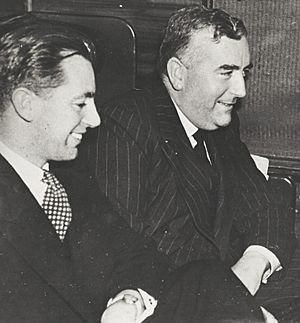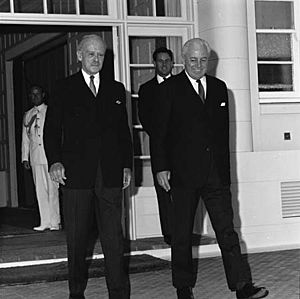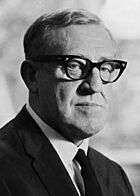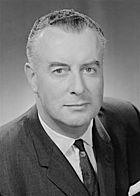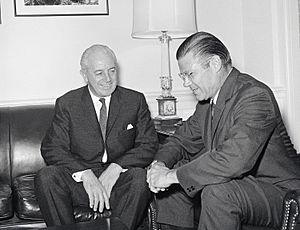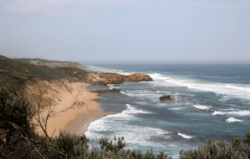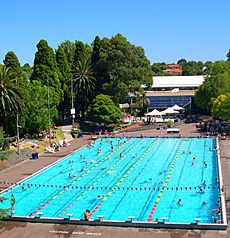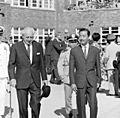Harold Holt facts for kids
Quick facts for kids
Harold Holt
|
|||||||||||||||||||||||||||||||||||||||||||||||||||
|---|---|---|---|---|---|---|---|---|---|---|---|---|---|---|---|---|---|---|---|---|---|---|---|---|---|---|---|---|---|---|---|---|---|---|---|---|---|---|---|---|---|---|---|---|---|---|---|---|---|---|---|
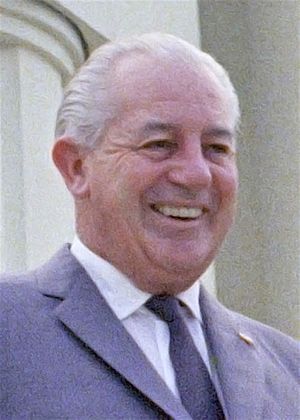
Holt at a SEATO leader's summit, 1966
|
|||||||||||||||||||||||||||||||||||||||||||||||||||
| 17th Prime Minister of Australia | |||||||||||||||||||||||||||||||||||||||||||||||||||
| In office 26 January 1966 – 18 December 1967 |
|||||||||||||||||||||||||||||||||||||||||||||||||||
| Monarch | Elizabeth II | ||||||||||||||||||||||||||||||||||||||||||||||||||
| Governor-General | Lord Casey | ||||||||||||||||||||||||||||||||||||||||||||||||||
| Preceded by | Robert Menzies | ||||||||||||||||||||||||||||||||||||||||||||||||||
| Succeeded by | John McEwen | ||||||||||||||||||||||||||||||||||||||||||||||||||
|
|||||||||||||||||||||||||||||||||||||||||||||||||||
|
|||||||||||||||||||||||||||||||||||||||||||||||||||
|
|||||||||||||||||||||||||||||||||||||||||||||||||||
| Personal details | |||||||||||||||||||||||||||||||||||||||||||||||||||
| Born |
Harold Edward Holt
5 August 1908 Stanmore, New South Wales, Australia |
||||||||||||||||||||||||||||||||||||||||||||||||||
| Died | 17 December 1967 (aged 59) Cheviot Beach, Victoria, Australia |
||||||||||||||||||||||||||||||||||||||||||||||||||
| Cause of death | Drowning (presumed) | ||||||||||||||||||||||||||||||||||||||||||||||||||
| Political party | United Australia (until 1945) Liberal (after 1945) |
||||||||||||||||||||||||||||||||||||||||||||||||||
| Spouse | |||||||||||||||||||||||||||||||||||||||||||||||||||
| Relations | Vera Pearce (aunt) | ||||||||||||||||||||||||||||||||||||||||||||||||||
| Children | 3 | ||||||||||||||||||||||||||||||||||||||||||||||||||
| Education | Randwick Public School Nubba State School Abbotsholme College Wesley College, Melbourne |
||||||||||||||||||||||||||||||||||||||||||||||||||
| Alma mater | University of Melbourne | ||||||||||||||||||||||||||||||||||||||||||||||||||
| Profession | Lawyer, politician | ||||||||||||||||||||||||||||||||||||||||||||||||||
| Signature |  |
||||||||||||||||||||||||||||||||||||||||||||||||||
| Nickname | Gunner Holt | ||||||||||||||||||||||||||||||||||||||||||||||||||
| Military service | |||||||||||||||||||||||||||||||||||||||||||||||||||
| Allegiance | Australia | ||||||||||||||||||||||||||||||||||||||||||||||||||
| Branch/service | Australian Imperial Force | ||||||||||||||||||||||||||||||||||||||||||||||||||
| Years of service | 1939–1940 | ||||||||||||||||||||||||||||||||||||||||||||||||||
| Rank | Gunner | ||||||||||||||||||||||||||||||||||||||||||||||||||
| Unit | 2/4th Field Regiment | ||||||||||||||||||||||||||||||||||||||||||||||||||
| Battles/wars | World War II | ||||||||||||||||||||||||||||||||||||||||||||||||||
Harold Edward Holt (born 5 August 1908 – died 17 December 1967) was Australia's 17th Prime Minister. He served from 1966 until his presumed death in 1967. He was the leader of the Liberal Party.
Holt was born in Sydney and later moved to Melbourne. He studied law at the University of Melbourne. Before becoming a politician, he worked as a lawyer. He was first elected to the House of Representatives at age 27 in 1935.
As a member of the United Australia Party, Holt became a minister in 1939. His time as a minister was paused when he briefly joined the Australian Army. He returned to government after some ministers died in a plane crash in 1940. When the Liberal Party was formed in 1945, he joined it.
| Top - 0-9 A B C D E F G H I J K L M N O P Q R S T U V W X Y Z |
Harold Holt: Australia's 17th Prime Minister
Early Life and Education
Harold Holt was born on 5 August 1908 in Stanmore, New South Wales, a suburb of Sydney. He was the first of two sons. His father, Thomas James Holt, was a physical education teacher. His mother, Olive May, had an actress sister named Vera Pearce.
In 1914, Holt's parents moved to Adelaide. Harold and his brother stayed in Sydney with an uncle. He attended Randwick Public School. Later, he went to Nubba State School and Abbotsholme College. In 1920, he started boarding at Wesley College, Melbourne. He was a bright student and won a scholarship. His mother passed away in 1925 when he was 16.
In 1927, Holt began studying law at the University of Melbourne. He lived at Queen's College on a scholarship. He played cricket and football for the university. He was also active in student groups. Holt won awards for speaking and writing. He graduated with a law degree in 1930.
Legal and Early Political Career
After university, Holt worked as a lawyer. It was hard to find clients during the Great Depression. He later became the secretary for a film industry group. This helped his law practice grow. He eventually had partners in his law firm.
In 1933, Holt joined the Young Nationalists. This was the youth group of the United Australia Party. He became friends with Robert Menzies, who later became Prime Minister.
Holt tried to enter parliament twice before succeeding. In August 1935, he won a special election for the seat of Division of Fawkner. He was 27 years old, making him the youngest member of parliament.
When Robert Menzies became Prime Minister in April 1939, he made Holt a minister without a specific department. Holt helped with the Council for Scientific and Industrial Research (CSIR). He also filled in for other ministers when they were away.
World War II Service
In February 1939, Holt joined the part-time army. In May 1940, he joined the Second Australian Imperial Force as a full-time soldier. He was a gunner in the artillery. He wanted to serve his country during World War II.
Holt's military service ended suddenly. On 13 August 1940, three senior ministers died in a plane crash. Prime Minister Menzies asked Holt to return to government. Holt became the Minister for Labour and National Service on 28 October 1940. He then officially left the army.
As Labour Minister, Holt worked to prevent strikes from affecting the war effort. He also helped create the Child Endowment Act. This law provided payments to families for their children. Holt was known as "the godfather to a million Australian children."
In 1941, the government changed leaders. Holt supported Arthur Fadden. Menzies felt betrayed but later forgave Holt. The government was defeated in October 1941. Holt then spent the rest of the war in opposition. He joined the new Liberal Party in February 1945.
Post-War Ministerial Roles
After eight years, the Liberal Party won the election in December 1949. Robert Menzies became Prime Minister again. Holt moved to a new safe Liberal seat called Higgins. He was given two important jobs: Minister for Labour and National Service (1949–1958) and Minister for Immigration (1949–1956).
As Immigration Minister, Holt continued and expanded Australia's immigration program after the war. He also made the White Australia policy less strict. For example, he allowed a Filipino man with an Australian family to stay in Australia.
Holt was very good in the Labour role. He helped reduce the number of working hours lost to strikes. He worked well with union leaders. He also had responsibility for the Melbourne Olympics in 1956.
Holt's reputation grew in the 1950s. He became a Privy Counsellor in 1953. In 1956, he was chosen as the Deputy Leader of the Liberal Party. From then on, he was seen as the likely next Prime Minister after Menzies.
Treasurer of Australia
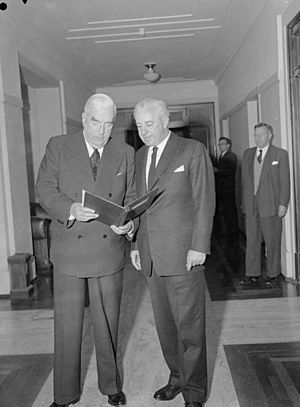
In December 1958, Holt became the Treasurer. This job confirmed his position as Menzies' successor. As Treasurer, Holt worked closely with the Treasury secretary, Roland Wilson.
He helped reform the banking system. He also planned for the introduction of decimal currency. Holt convinced the government to call the new currency the "dollar" instead of the "royal."
In 1960, Holt introduced some tax changes to control inflation. This led to a brief economic slowdown. Unemployment rose, which was unusual for the time. This almost caused the government to lose the 1961 election. However, the economy soon improved. Holt kept his position as Menzies' likely successor.
Prime Minister of Australia (1966–1967)
Harold Holt became Prime Minister on 26 January 1966. This happened after Robert Menzies retired. Holt was chosen as the Liberal leader without anyone opposing him. He was the first Australian Prime Minister born in the 20th century.
Holt was more relaxed and modern than Menzies. His wife often joined him in public. He gave the media more access than before. He was the first Prime Minister to hold regular press conferences and TV interviews.
Holt's first cabinet was similar to Menzies'. William McMahon became Treasurer. Senator Annabelle Rankin became the first woman to hold a ministerial job. A new government department for education and science was created in December 1966.
Winning the 1966 Election
On 26 November 1966, Holt won his first and only general election as Prime Minister. It was a big victory for his government. They gained 10 seats in the House of Representatives. This was a larger win than Menzies had ever achieved.
Many people thought the Labor Party's poor campaign helped Holt win. The Labor leader, Arthur Calwell, was 70 years old and not very popular. He also had disagreements with his deputy, Gough Whitlam. The public saw the Labor Party as divided.
The Vietnam War was a big issue in the election. Labor was against the war, but this made them seem weak on national security. Calwell also supported the White Australia policy. This made Labor seem old-fashioned. Holt was seen as more modern and friendly.
In early 1967, Arthur Calwell retired. Gough Whitlam became the new Labor leader. Whitlam was a much stronger opponent. He was better in the media and in parliament. The Labor Party started to recover. Some Liberals became unhappy with Holt's leadership.
Key Domestic Policies
Holt was a practical leader. He believed in finding common ground. He was seen as a moderate politician.
Economy and Currency
Holt was sometimes criticized for not being strong enough on economic issues. A major drought in 1965 slowed economic growth. He did not want to increase public spending.
The Australian dollar was introduced on 14 February 1966. This was a big change from the old pounds and shillings. In November 1967, Britain decided to reduce the value of its currency. Holt announced that Australia would not follow. This meant Australia left the sterling area. This decision caused tension with the Country Party.
Immigration Reforms
As Prime Minister, Holt continued to make immigration laws more open. In March 1966, the time needed to become an Australian citizen was changed to five years for everyone. Before, it was 15 years for non-white people. Rules about families joining each other were also removed.
This led to more Asian immigrants becoming Australian citizens. Holt said that new immigrants would be judged on their suitability as settlers. They also needed to be able to fit in easily and have useful skills for Australia.
Holt was careful to present these changes as small adjustments. This was to avoid upsetting people who supported the old "White Australia" policy. However, outside Australia, he told journalists that the White Australia policy no longer existed.
Constitutional Changes
In 1967, Holt's government changed the Australian Constitution. This gave the federal government the power to make laws for Indigenous Australians. It also allowed Indigenous people to be counted in the census.
These changes needed a referendum (a public vote). Over 90 percent of Australians voted yes. This is still the largest referendum majority in Australian history. Holt saw this as a sign of a changing national mood.
After the vote, Holt visited Aboriginal communities. He talked with Indigenous leaders. He created a new Office of Aboriginal Affairs to help Indigenous people. This was a big step in how the government handled Indigenous affairs.
Holt also tried to change another part of the constitution. This was about the number of members in parliament. However, this referendum did not pass.
Support for the Arts
In November 1967, Holt announced the creation of the National Gallery of Australia. He also announced the Australia Council for the Arts. The National Gallery was the first major arts project funded by the federal government. The Australia Council was created to advise the government on arts funding. Holt believed these would greatly improve Australia's cultural life.
Foreign Policy and Global Connections
Holt believed it was his job to show a modern Australia to the world. He focused on opposing communism and connecting more with Asia. He thought that if communism spread, it would threaten Australia.
Holt was good at personal diplomacy. He believed in building strong relationships with other world leaders. His first overseas trip as Prime Minister was to Southeast Asia in April 1966. He visited Malaysia, Singapore, South Vietnam, and Thailand. He also visited Cambodia, Laos, South Korea, and Taiwan in 1967. Most of these countries had never been visited by an Australian Prime Minister before.
The Vietnam War
The Vietnam War was the main foreign policy issue during Holt's time. He strongly supported Australia's involvement in the war. He believed Australia had a duty to fight communism. He said that if small nations were not safe, no nation would be safe.
In March 1966, Holt announced that Australia would send more troops to Vietnam. This tripled the number of Australian soldiers there. By the end of his time as Prime Minister, Australia had over 8,000 personnel in South Vietnam. Holt always supported American bombing in North Vietnam. He hoped that more troops would lead to victory.
The public initially supported the war. This helped Holt win the 1966 election. However, by late 1967, public opinion started to turn against the war.
"All the Way with LBJ"
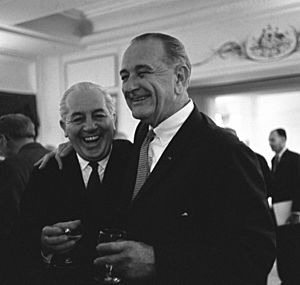
Holt built a close friendship with U.S. President Lyndon B. Johnson. He believed that without American help, Australia and other countries in the region would feel unsafe. Australia also helped the U.S. by building tracking stations for NASA and intelligence agencies.
Holt visited the U.S. twice in 1966. He even stayed at Camp David with President Johnson. In October 1966, Johnson visited Australia. He was the first U.S. President to do so. He was met by large crowds, but also by anti-war protesters.
During his first U.S. visit, Holt made a famous remark. He said Australia would be "all the way with LBJ." He meant it as a friendly gesture. However, in Australia, many saw it as a sign of Australia being too submissive to the U.S. This comment is still remembered as Holt's most famous saying.
Relations with Britain
Holt strongly supported the Commonwealth of Nations. He believed its members had duties to each other, especially Britain. However, his relationship with British Prime Minister Harold Wilson was not always easy.
Holt wanted Britain to keep a strong military presence in Asia. He believed it would help American efforts. But in 1967, Wilson announced that Britain would close most of its bases in Asia. Holt felt that Wilson had misled him.
Disappearance of Harold Holt
Harold Holt loved the ocean and spearfishing. He had holiday homes near the coast. On 17 December 1967, Holt was spending the weekend at Portsea, Victoria. He and some friends went to Cheviot Beach for a swim. Holt had spearfished there many times before.
The ocean conditions were rough that day. Only one other person joined Holt in the water. Holt swam out into deeper water and was caught in a strong rip. He disappeared from view. One witness said it was "like a leaf being taken out... so quick and final."
A huge search operation began, but Holt's body was never found. On 18 December, he was officially presumed dead. A police report in 1968 found no clear cause of death. A later investigation in 2005 concluded he likely drowned accidentally.
Holt's disappearance led to many conspiracy theories. Some suggested he faked his death or was taken by a submarine. Holt was 59 years old when he died. He was the third Australian Prime Minister to die in office.
John McEwen, the leader of the Country Party, became caretaker Prime Minister. The Liberal Party then chose John Gorton as their new leader.
Personal Life
While at university, Holt met Zara Dickins. They planned to marry, but separated for a time. Zara later married James Fell and had three children: Nicholas, Sam, and Andrew. Her marriage ended, and she returned to Australia. She and Holt restarted their relationship.
Harold and Zara married on 8 October 1946. Holt legally adopted Zara's three children, and they took his surname. Zara Holt was a successful businesswoman. She owned dress shops and earned more money than her husband. Her success allowed them to buy two holiday homes. Zara often traveled with Holt on his overseas trips.
After Holt's death, Zara married again in 1969 to Jeff Bate, another Liberal politician. She passed away in 1989.
Holt was the first Australian Prime Minister born in the 20th century. He was an active sportsman and loved swimming. This made him popular with the public.
Memorials and Other Legacies
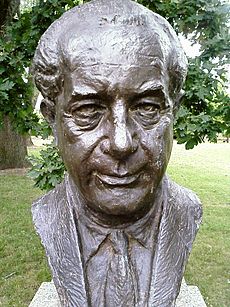
Harold Holt is remembered in several ways. The Harold Holt Memorial Swimming Centre in Melbourne was named after him. A swimming pool in South Vietnam was also named in his honor.
In 1968, a United States Navy warship, the USS Harold E. Holt, was named after him. It was the first American warship named after a foreign leader. A plaque commemorating Holt was placed on the seafloor off Cheviot Beach in 1969.
Other memorials include:
- The suburb of Holt, Australian Capital Territory.
- The Naval Communication Station Harold E. Holt.
- The Division of Holt, an electoral district in Victoria.
- A sundial and garden in the Fitzroy Gardens, Melbourne.
- A wing for boarders at Wesley College, Melbourne.
- The Harold Holt Fisheries Reserves, which are protected areas in southern Port Phillip.
- A memorial stone in the 'Prime Ministers Garden' of Melbourne General Cemetery.
In Australian slang, "do a Harold Holt" means to "disappear suddenly and without explanation." This comes from his disappearance.
In 1968, Holt's widow, Zara, was made a Dame Commander of the Order of the British Empire. She became Dame Zara Holt. The mineral holtite is also named in his honor.
See also
 In Spanish: Harold Holt para niños
In Spanish: Harold Holt para niños
- Declared death in absentia
- First Holt Ministry
- List of people who disappeared
- Second Holt Ministry
Images for kids
-
Holt and Prime Minister Nguyễn Cao Kỳ of South Vietnam on Kỳ's visit to Australia in 1967
-
Harold and Zara Holt meeting with Harold and Mary Wilson in 1967


